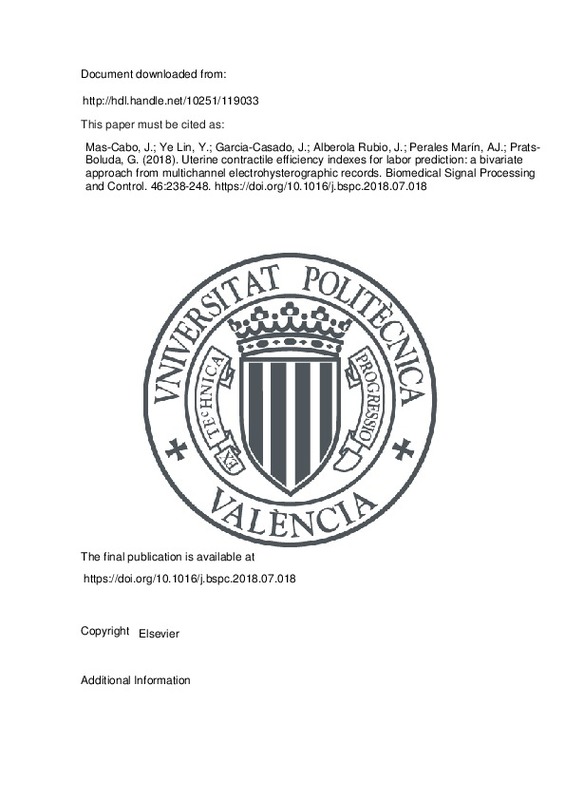JavaScript is disabled for your browser. Some features of this site may not work without it.
Buscar en RiuNet
Listar
Mi cuenta
Estadísticas
Ayuda RiuNet
Admin. UPV
Uterine contractile efficiency indexes for labor prediction: a bivariate approach from multichannel electrohysterographic records
Mostrar el registro sencillo del ítem
Ficheros en el ítem
| dc.contributor.author | Mas-Cabo, Javier
|
es_ES |
| dc.contributor.author | Ye Lin, Yiyao
|
es_ES |
| dc.contributor.author | Garcia-Casado, Javier
|
es_ES |
| dc.contributor.author | Alberola Rubio, José
|
es_ES |
| dc.contributor.author | Perales Marín, Alfredo Jose
|
es_ES |
| dc.contributor.author | Prats-Boluda, Gema
|
es_ES |
| dc.date.accessioned | 2019-04-06T20:05:57Z | |
| dc.date.available | 2019-04-06T20:05:57Z | |
| dc.date.issued | 2018 | es_ES |
| dc.identifier.issn | 1746-8094 | es_ES |
| dc.identifier.uri | http://hdl.handle.net/10251/119033 | |
| dc.description.abstract | [EN] Labor prediction is one of the most challenging goals in obstetrics, mainly due to the poor understanding of the factors responsible for the onset of labor. The electrohysterogram (EHG) is the recording of the myoelectrical activity of myometrial cells and has been shown to provide relevant information on the electrophysiological state of the uterus. This information could be used to obtain more accurate labor predictions than those of the currently used techniques, such as the Bishop score, tocography or biochemical markers. Indeed, a number of efforts have already been made to predict labor by this method, separately characterizing the intensity, the coupling degree of the EHG signals and myometrial cell excitability, these being the cornerstones on which contraction efficiency is built. Although EHG characterization can distinguish between different obstetric situations, the reported results have not been shown to provide a practical tool for the clinical detection of true labor. The aim of this work was thus to define and calculate indexes from multichannel EHG recordings related to all the phenomena involved in the efficiency of uterine myoelectrical activity (intensity, excitability and synchronization) and to combine them to form global efficiency indexes (GEI) able to predict delivery in less than 7/14 days. Four EHG synchronization indexes were assessed: linear correlation, the imaginary part of the coherence, phase synchronization and permutation cross mutual information. The results show that even though the synchronization and excitability efficiency indexes can detect increasing trends as labor approaches, they cannot predict labor in less than 7/14 days. However, intensity seems to be the main factor that contributes to myometrial efficiency and is able to predict labor in less than 7/14 days. All the GEls present increasing monotonic trends as pregnancy advances and are able to identify (p < 0.05) patients who will deliver in less than 7/14 days better than single channel and single phenomenon parameters. The GEI based on the permutation cross mutual information shows especially promising results. A simplified EHG recording protocol is proposed here for clinical practice, capable of predicting deliveries in less than 7/14 days, consisting of 4 electrodes vertically aligned with the median line of the uterus. (C) 2018 Elsevier Ltd. All rights reserved. | es_ES |
| dc.description.sponsorship | The authors are grateful to Zhenhu Liang, of the Yanshan University, who provided essential information for computing the PLV and NPCMI synchronization indexes. This work was supported by the Spanish Ministry of Economy and Competitiveness and the European Regional Development Fund (DPI2015-68397-R, MINECO/FEDER). | |
| dc.language | Inglés | es_ES |
| dc.publisher | Elsevier | es_ES |
| dc.relation.ispartof | Biomedical Signal Processing and Control | es_ES |
| dc.rights | Reconocimiento - No comercial - Sin obra derivada (by-nc-nd) | es_ES |
| dc.subject | Electrohysterogram | es_ES |
| dc.subject | Synchronization | es_ES |
| dc.subject | Nonlinear analysis | es_ES |
| dc.subject | Efficiency indexes | es_ES |
| dc.subject.classification | TECNOLOGIA ELECTRONICA | es_ES |
| dc.title | Uterine contractile efficiency indexes for labor prediction: a bivariate approach from multichannel electrohysterographic records | es_ES |
| dc.type | Artículo | es_ES |
| dc.identifier.doi | 10.1016/j.bspc.2018.07.018 | es_ES |
| dc.relation.projectID | info:eu-repo/grantAgreement/MINECO//DPI2015-68397-R/ES/ELECTROHISTEROGRAFIA, CONSTRUYENDO PUENTES PARA SU USO CLINICO EN OBSTETRICIA/ | es_ES |
| dc.rights.accessRights | Abierto | es_ES |
| dc.contributor.affiliation | Universitat Politècnica de València. Departamento de Ingeniería Electrónica - Departament d'Enginyeria Electrònica | es_ES |
| dc.contributor.affiliation | Universitat Politècnica de València. Servicio de Alumnado - Servei d'Alumnat | es_ES |
| dc.contributor.affiliation | Universitat Politècnica de València. Instituto Interuniversitario de Investigación en Bioingeniería y Tecnología Orientada al Ser Humano - Institut Interuniversitari d'Investigació en Bioenginyeria i Tecnologia Orientada a l'Ésser Humà | es_ES |
| dc.description.bibliographicCitation | Mas-Cabo, J.; Ye Lin, Y.; Garcia-Casado, J.; Alberola Rubio, J.; Perales Marín, AJ.; Prats-Boluda, G. (2018). Uterine contractile efficiency indexes for labor prediction: a bivariate approach from multichannel electrohysterographic records. Biomedical Signal Processing and Control. 46:238-248. https://doi.org/10.1016/j.bspc.2018.07.018 | es_ES |
| dc.description.accrualMethod | S | es_ES |
| dc.relation.publisherversion | https://doi.org/10.1016/j.bspc.2018.07.018 | es_ES |
| dc.description.upvformatpinicio | 238 | es_ES |
| dc.description.upvformatpfin | 248 | es_ES |
| dc.type.version | info:eu-repo/semantics/publishedVersion | es_ES |
| dc.description.volume | 46 | es_ES |
| dc.relation.pasarela | S\367929 | es_ES |
| dc.contributor.funder | Ministerio de Economía, Industria y Competitividad | es_ES |







![[Cerrado]](/themes/UPV/images/candado.png)

